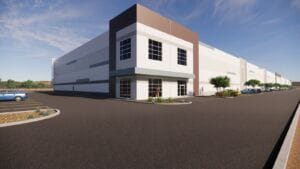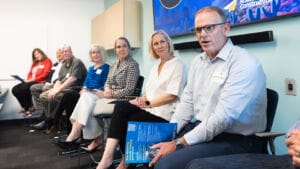Housing and health are inextricably connected. Quality, affordable housing is about more than shelter; it’s about a sense of community, the security that comes with having a stable place to live and the opportunity for self-advancement. It’s about physical, mental and emotional well-being. Without access to an affordable home, achieving an optimal quality of life is impossible.
“Most people associate healthcare with medicine and doctors, but it’s much broader than that, because housing is so elemental to our health,” says C.J. Hager, former director of Healthy Communities for Vitalyst Health Foundation, a Phoenix-based nonprofit that works to improve the health of individuals and communities throughout Arizona. “The built environment is a substantial contributor to our health, and how we interact with the built environment and the social elements associated with it have huge and often unrecognized impacts on health outcomes.”
READ ALSO: Residential real estate trends to watch in 2022
Beginning in August 2020, member-led task forces organized by ULI district councils in Chicago, Phoenix, Sacramento and Tampa worked to address local policy and regulatory barriers to creation of healthier and more equitable places. These initiatives were part of ULI’s District Council Task Forces for Health and Social Equity Project, led by ULI’s Building Healthy Places Initiative with support from the Robert Wood Johnson Foundation. ULI Arizona teamed with Vitalyst to create the Housing, Health and Equity Task Force to lead discussions and research into housing affordability challenges facing Metro Phoenix. “We need to have healthier communities,” Hager notes. “But often there are no tangible recommendations about how to achieve that with respect to housing.” The task force focused on identifying housing inequalities and addressing possible solutions and ways the real estate industry and partners can step in to meet these needs.
According to the resulting report, “Advancing Health and Equity through Workforce Housing,” Metro Phoenix used to be one of the most affordable regions in the country, but rising land costs, stagnant wages and an influx of new residents competing for places to live have contributed to decreasing housing affordability.
Workforce housing is considered attainable for families earning 60% to 120% of the area median income (AMI). For fiscal year 2020-2021, the AMI for a family of four in Greater Phoenix was $77,800. Housing for those making less than 60% AMI is considered low-income/subsidized, while greater than 120% is considered market rate.
“Workforce housing is generally for middle-income earners and supports our teachers, firefighters, bank tellers, essential service providers, police and emergency medical technicians,” says Maria Laughner, economic development program manager for the City of Tempe.
Hagar adds, “The folks who are working but who are having a hard time finding housing that fits into their budgets typically end up being workers with lower to moderate incomes, and especially people of color.”
Interactive data in the ULI Terwilliger Center 2021 Home Attainability Index shows that fewer than 24% of homes in the Phoenix-Mesa-Scottsdale metropolitan statistical area (MSA) are affordable to a four-person family earning 80% of the AMI; only 40% are available to those earning 120%. The MSA also ranks among regions with worse-than-median affordability.
“The whole Valley is in crisis,” Laughner points out. Workforce housing, in particular, is in diminishing supply. “There are far more people looking to buy or rent than there are units available, especially affordable to middle income levels,” she notes.
Also highlighted in The Workforce Housing report is a sobering Robert Woods Johnson Foundation statistic: People in resource rich, more expensive zip codes typically live longer than residents in underserved, under-resourced areas. In fact, life expectancy in the Valley can vary by up to 14 years depending on where you live.
In Tempe, growing demand outstrips consistent inventory and high-end multifamily products are experiencing a development boom. To help boost housing for all income levels, the city passed the Affordable Housing Strategy in July 2019. “Tempe was early to the table in this conversation. It had already decided what kind of initiatives it would offer developers if they provided some affordability,” explains Silvia Urrutia, founder and CEO of U Developing and Task Force co-chair with Hager.
While federal and state subsidies, such as the Low-Income Housing Tax Credits, are available to fill financing gaps, the same gap financing is limited when it comes to workforce housing. As such, Tempe has taken a unique approach to raise additional funding.
One year ago, the Tempe City Council approved the Home Town for All initiative. For every project built in Tempe, 50% of certain permitting fees paid to the city are directed to the Tempe Coalition for Affordable Housing. The money is used to buy and renovate properties or purchase land and request offers from developers to build workforce housing. To date, the initiative has raised more than $6 million and created 100 affordable units. “We’re making strides, but it’s a drop in the bucket when you think of how many people are in need of homes,” Laughner says.
She continues, “One of the things we’re seeing in Tempe is the impact of having people who can’t afford to live where they work. There are more workers in Tempe than there are residents. The in-migration of workers puts a significant strain on transportation and transit infrastructure.”
So what can municipalities do to strengthen workforce housing efforts?
Hager notes that land is one of the biggest costs in housing development. “There are some tools that are routinely used to help mitigate land costs,” she explains. “One is a land bank, which acquires land for future development, and the other is a community land trust, which is a form of shared equity homeownership. A nonprofit community based organization acquires land and maintains ownership of the land in perpetuity for the benefit of the community. There are several community land trusts in Arizona, such as Newtown Community Development Corporation, and they are doing some really great things that should be scaled and expanded.”
Planning, zoning, financing, partnerships and sustainable design also offer viable solutions. “If we really want to accelerate the development of affordable housing, we need to step into the flexibility of the planning and regulation tools at hand,” Hager continues. This includes removing barriers and creating new zoning incentives; encouraging the efficient and creative use of land and partnerships; leveraging public and private financing sources to fill in gaps to make projects feasible at lower price points; building more missing middle, gentle density designs, such as row townhouses, bungalows and multiplexes; allowing accessory dwelling units in more residential districts, and establishing standards for prefabricated building and construction elements.
First and foremost, though, is making housing affordability a priority and developing comprehensive strategies that coordinate action among all the partners working on healthy, equitable housing opportunities.
“Housing inequities that exist in neighborhoods have direct links to other social needs in terms of healthcare, employment, transportation and educational achievement,” Laughner concludes. “And that affects us all.”
For more information and to download “Advancing Health and Equity through Workforce Housing,” visit arizona.uli.org/get-involved/housing-health-equity-task-force.
Case Study: Tempe Micro Estates
According to the ULI Terwilliger Center for Housing, households in the 60th income percentile of middle income ($30,000-$75,000 per year) are spending more than half of their income on housing. Many of these families who are being priced out of the rental market can afford a mortgage, but competition for available housing is fierce. One unique project, the first of its kind in the region, aims to provide affordable workplace housing on community-owned land.
Developed in partnership with the City of Tempe by nonprofit land trust Newtown Community Development Corporation, Tempe Micro Estates comprises 13 600-square-foot one-bedroom homes that will be sold to people who earn 80% of the area median income (AMI).
The contemporary two-story structures, designed by coLAB studio and built by 180 Degrees, cost $170,000, with a down-payment of $5,500, for those earning 80% or less; the price increases for those earning between 80% and 120%. Those who make more than 120% are ineligible to purchase into the community.
Because the properties are on a land trust and salaries are capped, if the homeowner decides to move, he or she must sell the residence back to Newtown CDC. “We don’t believe it’s the homeowner’s responsibility to figure out if the buyer is under 80% AMI,” explains Stephanie Brewer, executive director for Newtown CDC. “We buy the house off the market, we sell it to the next individual, and we keep ownership of the land. That way we can keep the costs down in perpetuity.”




